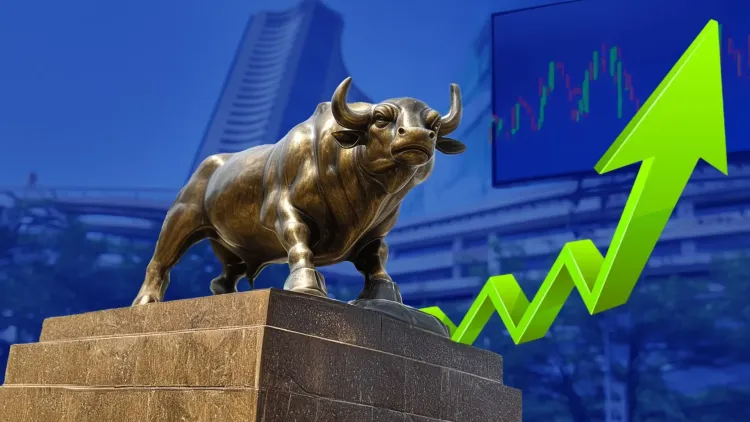Is GST Reform the Catalyst for Sensex's 676-Point Surge and Nifty's 245-Point Gain?

Synopsis
Key Takeaways
- Sensex surged by 676 points to close at 81,273.75.
- Nifty gained 245 points, finishing at 24,876.95.
- Positive sentiment is driven by anticipated GST reforms.
- The automobile sector emerged as a key beneficiary.
- Broader indices also showed significant gains.
Mumbai, Aug 18 (NationPress) The Indian stock market closed positively on Monday, fueled by significant investments in automobile, banking, and consumer durable sectors, reflecting the optimistic atmosphere surrounding the anticipated GST reforms.
The Sensex finished at 81,273.75, marking an increase of 676.09 points or 0.84 percent. It opened the day with a substantial gap-up at 81,315.79 compared to the previous closing of 80,597.66. The index, driven by widespread buying following the GST reform announcement, hit an intraday peak of 81,765.77.
The Nifty concluded at 24,876.95, rising by 245.65 points or 1.0 percent.
According to Vinod Nair, Head of Research at Geojit Investments Limited, "The proposed GST rationalization acts as a sentiment booster for the domestic market. Furthermore, the recent US and Russia summit concluded without escalating geopolitical tensions, which has alleviated investor concerns."
The automobile sector excelled, becoming a major beneficiary of the anticipated tax reforms. Nair anticipates that the consumption-driven sectors will gain traction due to demand recovery in H2 FY26.
Among the top gainers in the Sensex category were Maruti Suzuki, Bajaj Finance, Ultratech Cement, Adani Ports, Bajaj Finserv, Mahindra and Mahindra, Hindustan Unilever, Trent, Asian Paint, Tata Steel, Tata Motors, Axis Bank, and Bharti Airtel. Conversely, ITC, Eternal, Tech Mahindra, L&T, NTPC, and Infosys were the primary losers.
The Nifty Auto led the sectoral rally, climbing 1,008 points or 4.18 percent, with most sectoral indices finishing the session with commendable gains. Meanwhile, Nifty Bank increased by 393 points or 0.71 percent, Nifty Fin Services rose by 275 points or 1.05 percent, and Nifty FMCG closed 647 points or 1.19 percent higher. In contrast, Nifty IT ended in the negative zone.
The broader indices followed suit, with Nifty Next 50 rising 888 points or 1.34 percent, Nifty 100 climbing 266 points or 1.05 percent, Nifty Midcap 100 jumping 608 points or 1.08 percent, and Nifty Small Cap 100 finishing 242 points or 1.38 percent up.
Meanwhile, the rupee appreciated by 0.24 paise, closing at 87.31.
Jateen Trivedi of LKP Securities mentioned, "The GST reform initiative is part of policymakers' efforts to support the economy amid ongoing export pressures due to US tariffs. The rupee is expected to fluctuate between 87.00 and 87.75."









